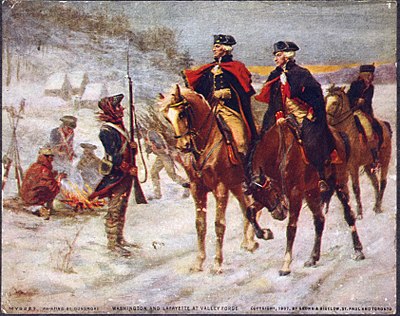Valley Forge
| Valley Forge | |||||||
|---|---|---|---|---|---|---|---|
| Part of the American Revolutionary War | |||||||
|
Washington and Lafayette at Valley Forge |
|||||||
|
|||||||
| Belligerents | |||||||
|
|
|
||||||
| Commanders and leaders | |||||||
|
|
|
||||||
| Strength | |||||||
| 12,000 | 15,000 | ||||||
| Casualties and losses | |||||||
| 2,000 + died | n/a | ||||||
Valley Forge was the military camp 18 miles northwest of Philadelphia where the American Continental Army spent the winter of 1777–78 during the American Revolutionary War. Starvation, disease, malnutrition, and exposure killed more than 2,500 American soldiers by the end of February 1778.
General George Washington sought quarters for his men with winter almost setting in, and with greatly diminishing prospects for campaigning. Washington and his troops had fought in early December what was the last major engagement of 1777 at the Battle of White Marsh (or Edge Hill). He devised to pull his troops from their present encampment in the White Marsh area (now Fort Washington State Park) and move to a more secure location for the coming winter.
Several locations were considered for the army's winter quarters, but Washington selected Valley Forge, Pennsylvania, 20 miles (30 km) northwest of Philadelphia. Valley Forge was named for an iron forge on Valley Creek in Whitemarsh, Pennsylvania. It was not the best place to set up winter camp for the Continental Army, as it was unable to defend southern Pennsylvania at the time. This location also left the vulnerable under-supplied army in striking distance of the British, who were well provisioned and secured in Philadelphia. The area was close enough to the British to keep their raiding and foraging parties out of the interior of Pennsylvania, yet far enough away to halt the threat of British surprise attacks.
The densely forested plateau of Mount Joy and the adjoining two-mile-long (3 km) plateau of Mount Misery made the area easily defensible, combined with the Schuylkill River to the north. It also provided abundant forests of timber that were used to construct thousands of log huts. Seventy-eight of the huts in the camp housed the soldiers, but more than 2,500 of those soldiers died.
...
Wikipedia

